![[Metroactive Music]](http://metroactive.com/music/gifs/music468.gif)
[ Music Index | San Jose | Metroactive Central | Archives ]
Rock Set in Stone: The multimedia displays of rock & roll memorabilia at the EMP in Seattle treat the genre as an object of worship.
Are We Experienced?
Microsoft co-founder Paul Allen's Experience Music Project in Seattle pays homage to one man's air-guitar dreams
By Gina Arnold
JUNE 23: OPENING DAY at the Experience Music Project, the NEW $240-million museum devoted to rock & roll memorabilia, and for once the sun is shining on Seattle. Hunched beneath the Space Needle at the Seattle Center--home of the 1962 World's Fair--the city's newest tourist attraction gleams brightly in the unexpectedly fine weather, sending shafts of golden light off its silver and purple steel sides.
Presently, Paul Allen himself, the museum's founder--and the co-founder of Microsoft--takes the podium. He wants, he says, to "give back" some of his own love of rock music by "creating a museum that expresses the dynamic, engaging, rebellious nature of popular music." And so he drops a pale-green electric guitar on a detonator, releasing streamers, balloons and confetti into the atmosphere.
The Mount Hood Jazz ensemble chimes in, and soon a desultory version of "Soul Man" is wafting along the breeze, sounding ever fainter amid the throng. Thus begins the life of the Experience Music Project--a visible tribute to the New Economy and the incredibly silly things that endless wealth can buy.
It still can't buy you love, but it can get you a private jam session with rock stars, like the one Allen, now suddenly anointed "King of Pop" in Seattle, took part in at the opening-night party, during which he jammed onstage with Herbie Hancock, Sheryl Crow and Robbie Robertson.
What did they play? Why, the 12-bar blues, of course--that hallowed chord progression that seems to have bewitched so many men of Allen's ilk--not just billionaires, but middle-aged, middle-class, middle-brow white men, the ones who all came of age in the 1960s, when rock & roll was a wild and scary and dangerous thing.
Back then, rock & roll exuded qualities like rebellion and nonconformity, as well as promising its adherents drugs, power and unlimited free sex. Thirty-five years later, however, rock & roll has been denuded of much of its charm, tamed and exploited by corporate greed, herded into nice, safe, environments like the Experience Music Project, its mystique shattered by the same evil forces that corrupted Jimi and Kurt.
Besides, these days, free sex and great drugs are to be had on any lousy street corner. Power, however, still lies within rock's provenance, and that is the apparent attraction for Allen, whose own field of expertise, computers, has earned him a vast fortune but somehow hasn't satisfied his inner need for glamour and entertainment.
Perhaps I accuse unjustly, but upon experiencing the Experience Music Project, I can't get over the sense that Allen built the whole thing just for the privilege of hanging out with rock stars. After all, a $240-million donation to the city coffers buys an unlimited number of backstage passes in Seattle--and, rumor had it, dates with the now-divorced Jerry Hall.
Such a donation also buys a museum designed by world-class architect Frank Gehry, which is in itself something: if the project fails, at least the building will stand. Built by a computer program that eleminates all right angles, the futuristic-looking building resembles a much less elegant version of Gehry's famous Guggenheim Museum in Bilbao, Spain--minus that edifice's gorgeous site, singular vision and classy purpose.
Instead of the magnificent silver slopes of the Goog, the EMP features bright colors--sky blue, cherry red, purple and silver--meant, it's said, to look like "a melted electric guitar." Inside its curvy stainless steel walls, the museum houses a small portion of more than 80,000 artifacts of rock history--guitars, clothing, set lists, photographs and other bizarre detritus detailing the last 40 years of pop culture.
The whole project comes much closer in spirit to an archaeological museum than to an art one. And perhaps that's a valid notion (although most archaeological museums display items that are at least 100 years old--not, as is the case here, things that are in some cases barely five years old.)
And so--despite the effusiveness of the Seattle city fathers, who have spent this weekend gushing about the building's conflation of "art, architecture, technology and spirit"--one can't help but wonder if this museum will be a working proposition five years down the road.
ALLEN'S FOLLY is not, of course, without precedent. After all, the history of art is the history of art patronage: without it, Michelangelo would not have painted the Sistine Chapel; Leonardo would not have created the Mona Lisa.
And privately owned and operated museums--like the Guggenheim--are nothing new either. Nevertheless, the Experience Music Project brings a whole new aspect to the idea of such collections. One can't help but wonder if this particular group of artifacts has any meaning for people who don't bring their own reverence and contextuality with them to the museum, already stored inside their heads. If not, they might have a problem. In the words of the old Lovin' Spoonful song, "It's like trying to tell a stranger about rock & roll."
To give credit where it's due, the EMP will set a new standard for the use of technology in this kind of environment. Each visitor, after paying the $20 entrance fee, receives a hand-held computer unit with headphones. When the visitor points this device at an exhibit, information appears on the screen that can be stored and or downloaded to one's own home computer (assuming one owns a home computer). Often, the headphones will play a song mentioned in the display or, in the case of the exquisite guitar gallery, which houses guitars dating back to the 19th century, will play each guitar's tone to show its difference.
Other uses of technology in the EMP include the sensurround video-frieze of the "Sky Church" auditorium, a sound lab where visitors can play around on rock & roll instruments (their boo-boos immediately corrected by computer program); the "Funk Blast" virtual-rock-concert ride, which puts the rider "inside" a James Brown concert; and another virtual-reality karaoke-type environment that allows visitors to pretend to be a rock band being cheered by the masses while "really" playing the song "Wild Thing" by the Troggs.
But for all its good intentions, there is something strangely unfunky about the entire exercise. For example, burgeoning guitarists who try to play anything on the guitar in the sound lab other than "Louie Louie" (the song it is programmed to teach) will be frustrated. There is no improvising allowed!
The museum promises to add to its collection via floating exhibits--in the hopes, no doubt, of attracting repeat customers at $20 each visit--and is also putting together a number of educational components, workshops, lectures and "rock & roll camps" for aspiring musicians.
Along with the memorabilia, these components make up the main purpose of the museum: "to celebrate innovation and creativity in American popular music, especially rock & roll," according to curator Christopher Bruce. But the fact is, despite brief forays into punk and hip-hop history, the EMP provides a highly personal and uncomprehensive view of rock.
There is a vague attempt made at chronology, history and relevance--but it is fairly feeble. Nowhere, for instance, does the museum mention the Beatles or the Rolling Stones. Curator Bruce says this is because to get involved in collecting those acts' memorabilia was much too complex. "To try to do anything even closely comprehensive with the Beatles ... well, it would take years to put anything together," he admits.
In other words, too much competition. Rather than get involved in that, the EMP curators stuck to the things that Allen deems important, a perspective that encompasses Jimi Hendrix and other late-'60s blues guitarists like Eric Clapton and Jimmy Page and the kind of American Mississippi delta blues artists those artists imitated.
Allen grew up in the Seattle area and so has devoted much space to Seattle-area rock bands over the years. Some of these bands, like the Sonics, the Kingsmen, Nirvana and Pearl Jam, are both important and interesting to museum patrons. Others, like the Fleetwoods, Heart, TKO, Rail and even, say, Earth or Dead Moon, distinctly aren't.
That said, EMP certainly delivers enough so that most people will find something to interest them. (My own jaw-dropper was the sight of the actual legal document, signed by his mother, giving the Replacements' manager custody of Tommy Stinson during the group's first tour.) And although the hip-hop display was not exactly completist, at least the punk and Pacific Northwest displays are fun to look at--the latter is hovered over (most frighteningly given Gehry's architecture), by the angel that graces the cover of Nirvana's LP In Utero.
INDEED, WHATEVER ELSE it is, there is no question that the EMP is a supreme effort of one man's idiosyncratic view of rock & roll made flesh. But it opens up a lot of questions about the nature of museums--and even more importantly, what is the role of personality in art.
The museum epitomizes one of the ways that rock & roll differs from other art forms, like painting and classical music. No one cares about Pablo Picasso's worn-out trousers or even his used palette. His paintings are paramount, the only real things of worth to do with him.
In rock, however, there is a terrible combining of art and artist--which may be why some fans (Allen included) don't just worship music but worship its detritus: autographs, set lists, guitars and old clothing. They imbue these fetishes with power in the same way that a peasant imputes spiritual power to the shroud of Turin--or an 8-year-old totemizes his baseball-card collection, as if owning a Derek Jeter card will somehow bring his batting average up.
Most of us outgrow the impulse to revere such objects. We no longer think that Bon Jovi is pointing directly at us when we go to his show, nor do we believe that touching Hendrix's guitar can bring him any closer to our hearts.
Or do we? The success or failure of EMP may hinge on the strength of the quasi-religious feelings that these kinds of relics invoke in the hearts and minds of rock fans. After all, the EMP is not so much a museum as a perspective: earnest and utterly sincere, yet also venal, misguided, primitive ... and childishly self-involved.
The point is obvious but still worth making: $240 million would buy a lot of kids meals, computers, drug counseling, music lessons in the schools, what have you. Luckily, there is one safeguard against Allen's terrible acquisitiveness--the monolithic nature of rock & roll itself.
When pitted against the incredible power of the music industry, even Allen is bound to be balked. Booking its grand-opening shows, for example, the EMP reportedly compiled a wish list of artists like Clapton, Neil Young, Bob Dylan, Pearl Jam, Santana. None of these stars materialized, because they were too booked up with "real" concerts.
Instead, the EMP was forced to resort to a co-produced concert with MTV and VH1, who provided (for broadcast) their current chart-toppers--acts that had nothing to do with the EMP's mission statement. The first night's concert featured Eminem, Kid Rock, Metallica and the Red Hot Chili Peppers, and the second night's lineup was only faintly less trendy, with Alanis Morissette, Beck, No Doubt and Matchbox 20. Also on the bill were the Eurythmics, whose leader, Dave Stewart, is in some creative partnership with Allen.
Stewart provides the "rock-star" element, and Allen provides--what else?--the cash. Their last project, a film called Honest, which featured the services of the English smash group All Saints, opened in London a month ago and had the amazing distinction of being (to quote the English press) "the biggest turkey of all time, doing even worst than a string of notorious box-office flops."
The Eurythmics set was reportedly marred by the loud sound of helicopters filming the concert. Eyewitness reports say that the band stopped playing and the audience booed until the helicopters went away. EMP's grand-opening weekend also included a number of free concerts around Seattle Center, featuring Patti Smith, Bob Mould, the Ventures, the Kingsmen, the Murder City Devils, Taj Mahal and many other bands.
On Sunday, there was also a Pacific Northwest showcase that was a genuine celebration of the survivors of Seattle's scene. It featured bands like the Young Fresh Fellows, the Fastbacks, Strychnine (members of Mudhoney doing songs of the Sonics), Sub Set (the Presidents of the U.S.A. with Sir-Mix-A-Lot on vocals), Built to Spill and the Screaming Trees. It was a heartfelt display of all the qualities that made Seattle a great town for rock.
That idea was confirmed by none other than former Nirvana bassist Krist Novoselic, in an impromptu display of solidarity, when he took the stage to introduce the Fastbacks. "There's been a lot of blood, sweat and tears to make this scene what it is today," he said. "But it's important to remember that money can't buy stature. That stature is earned."
Not surprisingly, Paul Allen was nowhere in sight.
[ San Jose | Metroactive Central | Archives ]
Copyright © 2000 Metro Publishing Inc. Metroactive is affiliated with the Boulevards Network.
For more information about the San Jose/Silicon Valley area, visit sanjose.com.
![]()
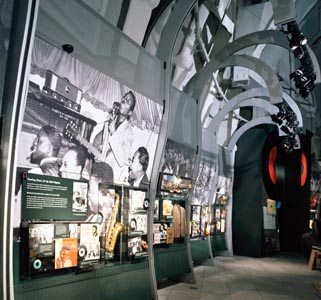
Photograph by Tim Streetporter
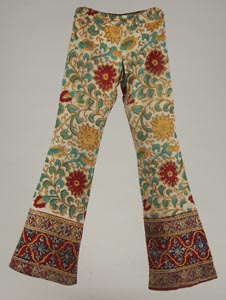 Artifact of Wonder: The collection of holy rock relics at the EMP includes a pair of bell-bottom pants owned by Janis Joplin.
Artifact of Wonder: The collection of holy rock relics at the EMP includes a pair of bell-bottom pants owned by Janis Joplin.
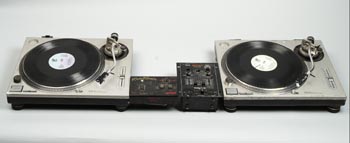
Spins: Grandmaster Flash's turntable setup from the late 1970s.
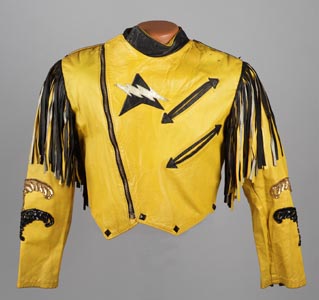
In Style: A flashy fringed jacket worn by Kid Creole.
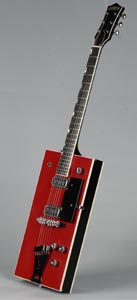 Hip to be Square: A Gretsch rectangular guitar made for Bo Diddley.
Hip to be Square: A Gretsch rectangular guitar made for Bo Diddley.
From the July 13-19, 2000 issue of Metro, Silicon Valley's Weekly Newspaper.